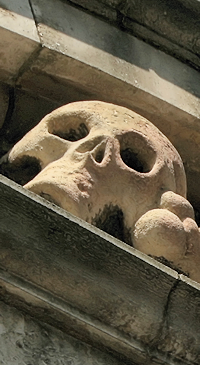St Olave Hart Street
Tales of St Ghastly Grim
St Olave Hart Street, City of London, EC3

It all began with the Battle of London Bridge, or so the story goes. This semi-legendary clash was fought in 1014 between an Anglo-Norwegian army and the Danish fleet of Sweyn Forkbeard, father of King Canute. Norway’s Olaf II sided with the England’s Ethelred the Unready because they were fellow Christians, while the wicked Danes were still inclined to paganism.
London Bridge is said to have been pulled down during the conflict, either by the Danes or by Londoners themselves as a defensive strategy. The event may be the source of the nursery rhyme ‘London Bridge is Falling Down’ as a similar poem commemorates the battle:
London Bridge is broken down,
Gold is won, and bright renown.
Shields resounding,
War-horns sounding,
Hild is shouting in the din!
Arrows singing,
Mail-coats ringing,
Odin makes our Olaf win!
Ottar Svarte, quoted in Snorri Sturluson: Heimskringla (c.1225) (translated by Samuel Laing, 1844)
The reference to Odin suggests that these were still early days for Norwegian christianity and there are doubts about the depth of the Olaf’s faith (and about the ungodliness of the Danes at that time) but he was nevertheless canonised soon after his death in 1030 and later became his country’s patron saint. Admiring Londoners dedicated several churches to him.
St Olave Hart Street is sometimes claimed to have been founded in 1056 but there’s no evidence to support the precision of this assertion. It may be roughly right because this was a period when memories of Olaf were at their most favourable – before Norway vainly attempted to invade England in 1066, a matter of days before the Normans succeeded.
Having almost certainly begun its existence as a wooden structure, St Olave’s was rebuilt in stone in the 13th century and rebuilt again in the 1450s. As with all churches of such vintage, many alterations and additions were made over the following centuries.
When a new churchyard gateway was built in 1658 it was ornamented in a macabre fashion that later prompted Charles Dickens to coin the nickname ‘St Ghastly Grim’:
“It is a small small churchyard, with a ferocious, strong, spiked iron gate, like a jail. This gate is ornamented with skulls and cross-bones, larger than the life, wrought in stone; but it likewise came into the mind of Saint Ghastly Grim, that to stick iron spikes atop of the stone skulls, as though they were impaled, would be a pleasant device. Therefore the skulls grin aloft horribly, thrust through and through with iron spears. Hence, there is attraction of repulsion for me in Saint Ghastly Grim, and, having often contemplated it in the daylight and the dark, I once felt drawn towards it in a thunderstorm at midnight.” (The Uncommercial Traveller)
The Great Plague of 1665 is said to have broken out very close to St Olave’s and 300 victims were buried in the churchyard, including the woman who was widely blamed for bringing the disease to the capital. In the parish register, the plague victims’ names are marked with a ‘p’.
In 1666 the flames of the Great Fire of London came within about a hundred yards of St Olave’s before the wind changed direction. The church may have been saved by the diligence of its most famous worshipper, Samuel Pepys, who ensured that neighbouring wooden structures were pulled down before the fire spread here.
Pepys lived in the parish for 14 years and his diary includes many observations of goings-on at St Olave’s services. He liked going to church in midwinter, because he was less afraid of walking through the churchyard when snow covered the graves. When Pepys died in retirement at Clapham his body was brought to St Olave’s to be entombed beside his wife Elizabeth. Every year on a date close to the anniversary of his death on 26th May, St Olave’s and the Samuel Pepys Club hold a commemoration service at which a distinguished speaker gives an address on some aspect of his life.
The church was severely damaged by bombing in the Second World War but enough of the fabric survived to permit the building to be superbly restored in the 1950s. King Haakon VII of Norway was guest of honour at the rededication ceremony.


